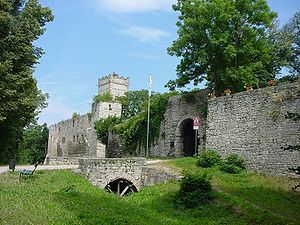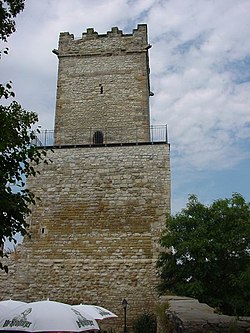Eckartsburg
| Eckartsburg | ||
|---|---|---|
|
Eckartsburg |
||
| Alternative name (s): | Eckartsberga | |
| Creation time : | around 998 | |
| Castle type : | Hilltop castle | |
| Conservation status: | ruin | |
| Standing position : | Counts, nobles | |
| Place: | Eckartsberga | |
| Geographical location | 51 ° 7 '17.4 " N , 11 ° 33' 32.8" E | |
|
|
||
The Eckartsburg , also known as Eckartsberga , is a partially preserved hilltop castle and is located on a ridge of the Finn landscape , more precisely on the southern edge of the foothills of the Finne ridge , above the small town of Eckartsberga in the Burgenland district , in the Saale-Unstrut-Triasland nature park , near the state border of Saxony -Stop to Thuringia . The castle is managed by a castle restaurant and is located on the Romanesque Road . The castle is managed by the Kulturstiftung Sachsen-Anhalt as owner.
construction
The castle consists of the main castle (the main castle) and the outer bailey ; it is entered through an 8.2 meter long archway. The archway has a niche as an apartment for the gatekeeper, which was also used as a prison. The main castle is accessible through a 10.4 meter long and 2.8 meter wide gate with three meter thick walls.
The preserved, 22-meter-high keep is based directly on the rock, has 2.50 meter thick walls and served as a prison and torture tower. Inside the keep, the barrel vault has an opening through which the prisoners were released into the prison. The tower door is at a height of nine meters.
The only remaining living rooms are on the south side of the castle and are used today as a restaurant and inn.
For the 1000th anniversary of the castle in 1998, the palace was rebuilt and is now used for cultural purposes. The maiden tower has windows and machicolation for defense.
The other (large) keep is 36 meters high, can be climbed (view) and has five floors. It was used as a watchtower and as accommodation. The first floor is now filled with rubble. A diorama and a smaller museum are now housed on the other floors. "The wall thickness is 2.5 meters up to the third floor, then approx. 1.5 meters, so that there is a battlements of one meter."
In the castle hall there is the original running bike of forester Karl Freiherr von Drais , which he developed in Karlsruhe in 1817.
history
Reichsburg
The builder of the castle is the Margrave of Meißen, Ekkehard I. He was enfeoffed with the Mark Meißen in 985 and is said to have built the castle in 998 on the Via Regia . However, there is no compelling evidence to support this assumption. If the castle was actually founded by the Ekkehardines , it fell back to the empire in 1046 when they died out. Until the investiture of the Landgrave of Thuringia with the rule of the plant remained imperial castle . The first reliable information about the existence of the castle is a document that was made out in 1066 by King Heinrich IV in Eckartsberga. In 1074 the Eckartsburg was named directly. For a short time between 1112 and 1115 the castle was loaned to Wiprecht von Groitzsch II.
Ludowinger
In 1121 the Thuringian Count Ludwig der Springer received the Eckartsburg as property as part of the reconciliation of the Thuringian aristocratic opposition with the Emperor. Udo , Bishop of Naumburg and brother Ludwig I , first documented it in 1134 at the castle.
The events described up to this point relate to a fortification which, with high probability, was not located on today's castle hill. During excavations that were carried out in 1901, no remains of a previous castle were found. Possibly the castle of 10/11 was located. Century in a rampart called Altenburg in the Mallendorf district.
Since 1185 frequent stays by Ludwig III. or his brother Hermann , Count Palatine of Saxony, proven in Eckartsberga. Hermann probably also built the walls of the core and outer bailey, which date from around 1200 and form an almost rectangular quarter . At that time, the castle consisted of the main castle, a western bailey and two eastern bailey. The rampart and neck ditch as well as the remains of a Romanesque keep (excavated in 1901, not visible) have been preserved from the large easternmost outer bailey. In the main castle, the Romanesque buildings that were built at the same time, consisting of a circular wall , keep, palace ruins and chamber gate are well preserved. Hermann I, Count Palatine of Saxony and later also Landgrave of Thuringia, is the founder and builder of the Romanesque Eckartsburg, which still exists today.
The castles of the landgraves were not only of military importance, they were also places of art and culture. Here the nobility cultivated literature, religion, historiography, music, painting and handicrafts. A particularly famous patron of the knightly courtly culture was Landgrave Hermann I. In the decades around 1200 he not only stayed at the Wartburg and Neuchâtel , but also more often at the Eckartsburg.
The importance of the Eckartsburg for the Ludowingers can also be seen in the fact that the marshal office was awarded to the ministerials of Eckartsberga. Landgrave ministers of Eckartsberga have been known in documents since 1140 . The Marshal's court office was associated with the Marschall family , who came from the Sherinburg and called themselves von Vargula from 1178 to 1184, but von Eckartsberga in 1186, until the end of the monarchy in 1918. The marshals of Eckersberg probably originally served as ministers at Eckartsburg.
Wettiner
After the death of Heinrich Raspe , a protracted war of succession followed in Thuringia, in which Eckartsburg was drawn from the beginning. The Wettin Heinrich the Illustrious conquered the castle in 1247 and built it into a base for the battles that followed. As a result of these disputes, which only ended in 1264, Thuringia lost its regional independence when the Landgraviate of Thuringia was incorporated into the Margraviate of Meissen. The Counts of Wettin, as Margraves of Meißen and Landgraves of Thuringia, had become one of the most important territorial powers of the German Empire .
A son of Henry the Illustrious, Albrecht the Degenerate , often stayed at the Eckartsburg, which became one of his favorite seats. The town of Eckartsberga probably owes its elevation to town in 1288 to him. In the following decades, the Wettin rulers had to cope with various problems and crises. The castle and town of Eckartsberga often changed hands. In 1388, for example, they were pledged to the Lords of Querfurt .
Eckartsburg also played a role in the 15th century as a place of exile for a high-ranking noble lady. This was related to the Wettin Duke Wilhelm III. the brave together. On the one hand he was regarded as a pious man devoted to the Church, on the other hand his political behavior gave the "impression of a rigid and inexorable personality". His personal circumstances were also subject to major fluctuations. So he expelled his wife Anna of Austria , daughter of the Roman-German King Albrecht II , because of a dispute over the dowry and instead turned to his lover Katharina von Brandenstein . Duchess Anna was brought to Eckartsburg in 1457 and, according to legend, was held captive in the Maiden Tower. In 1462 she died in her exile.
The division of the Wettin sovereignty in 1485 into the lines of the " Ernestines " and the " Albertines " was very important for the further history of Saxony and Thuringia - with aftermath up to the 20th century . This division of Leipzig between Elector Ernst and Duke Albrecht was at the beginning of the modern history of Central Germany. Eckartsberga and the Eckartsburg fell to the Albertine line, to which the Mark Meissen belonged. From then on, the Ernestine and Albertine princes went their separate ways, which led to ever more fragmentations, whereby the line of the Albertines remained connected to Saxon history.
Modern times
In 1657 the castle lay desolate, and in 1664 it was reported that only a few rooms were furnished for living. Inventory descriptions from the 18th century show that the castle was rebuilt and was used as a farmyard. In 1806, after the battle of Jena and Auerstedt, Prussian troops withdrew to Eckartsburg. That is why there is also a diorama of the battle in the castle.
Since 1815 the Eckartsberga rule was Prussian property. When the west tower threatened to collapse in 1815, demolition was prohibited for "reasons of antiquity". Friedrich Wilhelm III. von Prussia donated the funds for its restoration. In 1850 the economic use, which had previously served mainly as a grain storage facility, was given up. The building was threatened with gradual deterioration. However, the increasing popularity of the ruin meant that maintenance and conservation work was carried out on an ongoing basis. A restoration was opened at the castle as early as 1860 . It was located in the former grain bulk floor on the south side of the plant.
Around 1900 the expansion of the castle into a large excursion center with a festival hall and shooting hall was planned. However, the plans were not implemented for monument conservation and financial reasons. It was not until 1925 that the restaurant was expanded in the “old German” form that still exists today.
On a stone round bench in front of the entrance to the castle, a legend reads that Goethe's poem "Faithful Eckart" flowed from his pen here during an exchange of mail.
literature
- Friedrich von Sydow : History of the castles Schönburg and Eckartsburg near Naumburg. 1840/1842. Reprint: Thüringer Chronik-Verlag, Arnstadt 2000, ISBN 3-910132-89-8 .
- Christian Friedrich Prange: Contributions to the history of the Eckartsburg. Self-published by the author, printed in the Eckarthaus printing house, 1861.
- Heinrich Otte, Gustav Sommer: Descriptive representation of the older architectural and art monuments of the Eckartsberga district. Halle / Saale 1883.
- Louis Naumann : The Eckardsberga Eckardsburg Castle. Issues 1886, 1891, 1902.
- Louis Naumann: The ruins of Eckartsberge Castle and its former importance as a fortress. 1902.
- Louis Naumann: What happened to the former property of Eckartsberga Castle. 1883.
- Hans Werner Rothe : The Eckartsburg and Marienthal Castle near Eckartsberga. 1963.
- Boje Schmuhl, Konrad Breitenborn Stekovics: The Eckartsburg. 1998.
- Reinhard Schmitt : Castles of the high Middle Ages on the lower Unstrut and around Naumburg. To the state of research. In: Castles and palaces in Saxony-Anhalt. Special issue, Halle 1996.
- Reinhard Schmitt: The Eckartsburg. (= Great Architectural Monuments. Issue 445). German Art publishing house Munich / Berlin 1993.
Web links
Individual evidence
- ↑ eckartsburg.com Burgschänke opening times
- ↑ a b c d e f g City of Eckartsberga zu Eckartsburg





